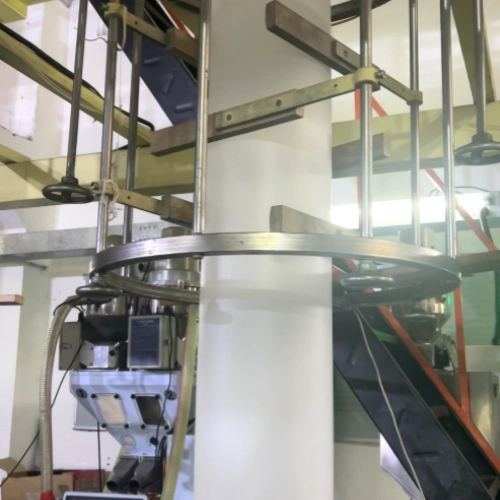Plastic bags are everywhere – from grocery stores to packaging industries, they play a vital role in our daily lives. But have you ever wondered how these versatile bags are manufactured? In this blog, we’ll take you through the fascinating process of plastic bag production, from raw materials to the finished product. If you’re interested, this guide breaks down the key steps in an easy-to-follow format.
Whether it’s a vest bag, a flat bag or a drawstring bag, all of these various plastic bags are plastic film products. To make plastic film, it must first be made into film. The industry calls this process blown film.

How to blow film?
- The Foundation: Resin Selection
The story begins with resin pellets—tiny beads of polymer, the building blocks of plastic. These pellets are engineered for specific purposes:
Polyethylene (PE): The most common resin, PE is lightweight, flexible, and durable. It comes in two main types:
- HDPE (High-Density PE): Stronger and stiffer, used for trash bags and grocery sacks.
- LDPE (Low-Density PE): Softer and more flexible, ideal for thin film applications like bread bags.
Biodegradable Resins: For eco-conscious products, manufacturers use resins blended with polylactic acid (PLA) or starch-based polymers, which decompose under composting conditions.
Recycled Content: Many resins now incorporate post-consumer recycled plastics, reducing reliance on virgin materials.
- The Blowing Film Process: Turning Pellets into Plastic Film
At the heart of plastic bag production lies the blown film extruder, a machine that melts, shapes, and cools resin into thin, continuous film. Here’s how it works:
Melting: Resin pellets enter a heated barrel where they’re melted into a viscous liquid. Temperatures range from 380–500°F (193–260°C), depending on the resin type.
Extrusion: A screw pushes the molten plastic through a circular die, forming a vertical tube called a bubble.
Inflation: Air is blown into the tube, inflating it like a balloon. The bubble’s size determines the film’s width, while the die gap controls thickness.
Cooling: As the bubble rises, air cools the plastic, solidifying it into a cylindrical shape.
Flattening: Collapsing frames press the bubble into flat, double-layered film, which is wound onto large rolls.
Advanced extruders use nanoparticles or UV stabilizers during melting to enhance film strength and weather resistance.
- Printing and Customization
Before bags are cut and sealed, the film undergoes printing.
Inks: Water-based or soy-based inks are eco-friendly , reducing volatile organic compounds (VOCs).
Design: Prints range from simple logos to complex patterns, with up to 8 colors applied in a single pass. - Bag Making: Cutting, Sealing, and Finishing
The final step transforms printed film into usable bags using bag-making machines:
Cutting: Rotary knives slice the film into predefined shapes—T-shirts, flat bags, or drawstring styles.
Sealing: Heat bars weld seams along the sides and bottom, creating strong, leak-proof edges.
User-Centric Finishing:
- Micro-Perforation Options: Pre-weakened tear lines allow clean separation (e.g., produce section grocery bags).
- Handle Engineering: Ergonomic die-cuts and reinforced stress points ensure comfortable, reliable transport.
- Quality Control and Testing
Professional manufacturers will strictly control the quality of the parameters of the bag.
Tensile Strength: Bags are pulled until they break, measuring durability.
Puncture Resistance: Steel probes simulate real-world wear.
Leak Testing: Pressurized air detects microscopic holes.
Biodegradability: For eco-bags, manufacturers will send plastic bags to professional testing institutions to ensure that they are truly degradable. Biodegradable plastic bags with EN 13432 and ASTM D6400 certification marks are trusted products by consumerslabs.
Environmental Impact and Future Trends
While plastic bags provide convenience, their environmental footprint sparks global debate. Luckily,the industry is changing:
Circular Economy: Brands like Loop and TerraCycle offer reuse programs, turning old bags into new products.
Chemical Recycling: Emerging technologies break down plastics into monomers, which can be reprocessed into virgin-quality resin.
Policy Shifts: Bans on single-use plastics in cities like Seattle and Delhi are pushing innovation in biodegradable alternatives.
Conclusion
Plastic bag manufacturing is a fascinating process. From the selection of resin based on chemical properties to the precision control of blown film, each step has the depth of knowledge of the industry. Increasing plastic pollution has driven a shift in the direction of the industry: the production of biodegradable bags, recycled materials and more. So that people can live better in the future without harming the planet.